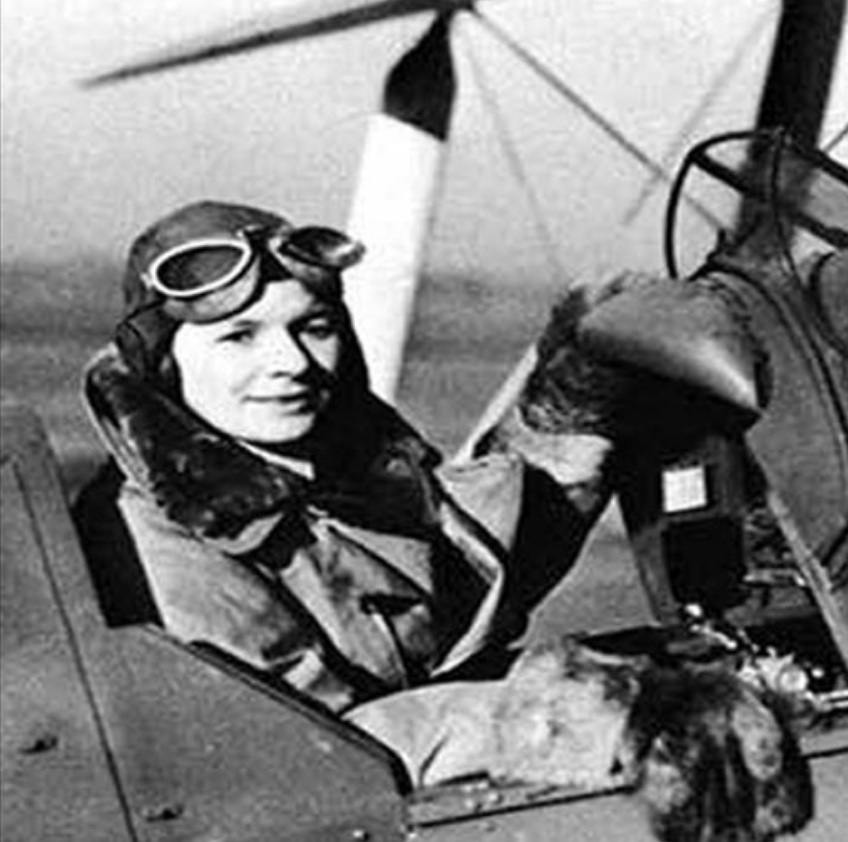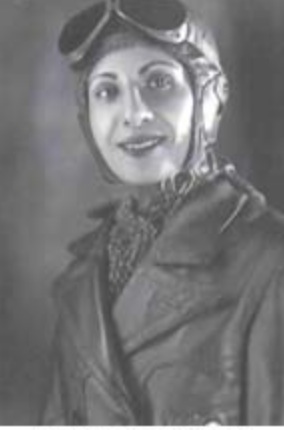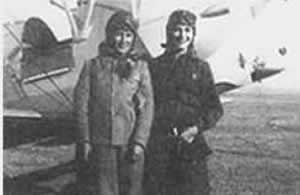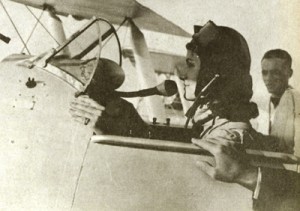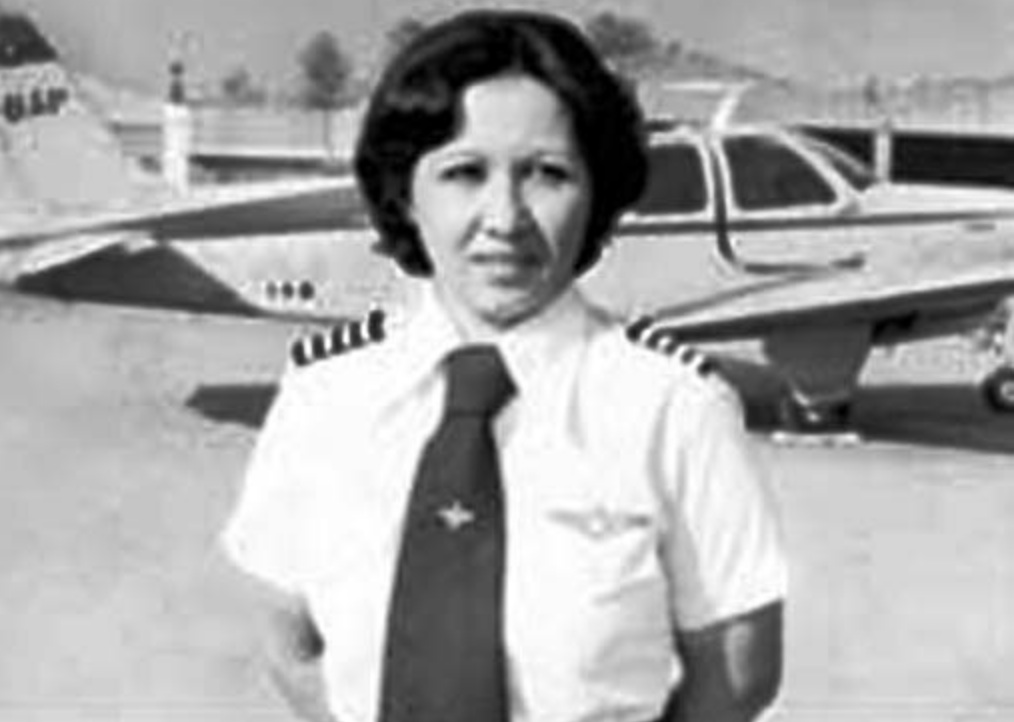The article below “Against the wind: Pioneer women pilots” was originally written by Abbas Atrvash on November 22, 2002 in The Iranian. Kindly note that a number of photos inserted into the article below did not appear in the original Iranian.com posting.
=========================================================
In 1908, Therese Peltier of France was the world’s first woman who piloted an aircraft. Two years later, Raymonde de Laroche of France was the first woman in the world to receive her pilot’s license. Between these years, a large number of women were attracted to flying. The extent of the women’s interest in an activity dominated by men was enormous.
In Europe and North America women attended flying schools to show off their ability in handling flying machines. Presently, women around the world fly aircraft and helicopters. They fly for the airlines, in the military and in space. However, one fact remains that all these women, have somehow, in one way or another, have encountered problems or hassled by their society.
In 1921, Bessie Coleman, the first African-American woman, when decided to become a pilot faced so many barriers in obtaining flight training in the United States that she had to go to France to pursue her dream. A 1994-95 survey of International Society of Women Airline Pilots on sexual harassment and gender discrimination reflects amazing examples of this nature, from verbal abuses to refusal of being flown with by men captains.
In Iran, the civilian pilot training began approximately 15 years after Iran acquired its first aircraft for the air force. Ret. Maj. Gen. Ali A. Rafat, then a young air force lieutenant, a pilot and flying instructor and later the managing director of Iranian Aero Club remembers:
“In 1939, Reza Shah, after returning from an official visit to Turkey ordered the founding of the Iranian Aero Club. The main objective of the club was to familiarize Iranian young men and women with aviation and train them to fly. However, among other things, carrying the mail within Iran would later become another activity of the club. A piece of land was acquired in an area in south west of Mehrabad airport and later on some aircrafts were purchased specifically for flight training“
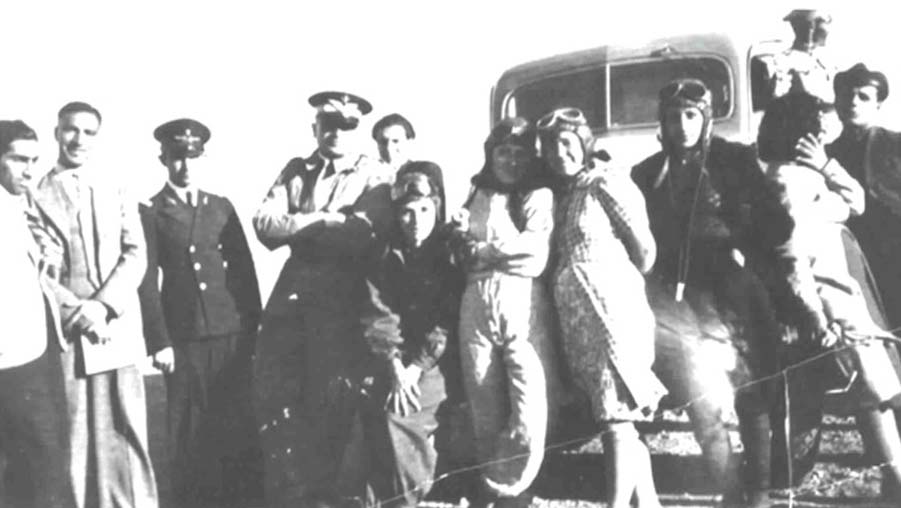
Iran’s pioneering women pilots posing with Iranian personnel/airmen and civilians – The club’s board of directors consisted of the prime minister; minister of finance, the director of Iran civil aviation organization; commander in chief of the Iranian air force and the managing director of the club. The first club’s managing director was Mr. Yasai, followed by Dr. Issa Sadigh-Alam, Gen. Hedayat Gilanshah, Maj. Gen. Ali A. Rafat and Gen. Nader Jahanbani. Reza Shah and members of his family were the first to become members of the club and paid their memberships. The first announcement for accepting flight trainees’ applicants was made by the club management, through newspapers, on 15th Aban 1318 (7 November 1939). Some 630 young men and women registered as members and trainee applicants. The club became extremely popular with young generation and its membership soared. The club gradually expanded its training to a great extent and included helicopter and glider flying, aircraft mechanics, parachute jumping and model aircraft. Branches were opened in several Iranian cities including Abadan, Kermanshah, Mashad, Shiraz and Esfahan. At that time civil aviation was quite a new concept and only a number of air force pilots and aircraft existed in Iran. Considering the novelty and fear of flying; and in the eyes of majority, the unreliability of planes in the early days of aviation, not many people were interested in flying. Most parents opposed the idea of flying for their children, thus discouraged them from becoming pilots. Only a limited number of courageous people were taken to the air. Starting 1939, women’s emancipation was just getting started and their involvement in social activities had barely started. Flying was supposed to be a man’s domain and was not yet unproblematic for women to enter. However, despite the prevailing situation, 22 women sailed against the wind and registered at the club. The first three pioneers who took the initiative to lead the way were, Effat Tejartchi, Sadiqeh Farrokhzad Dowlatshi and Ina Avshid. Effat Tejaratchi at the age of 22 with a burning desire of flying was the first to join the club. This daring woman, passed away in August 1999, at the age of 82. Thanks to her daughter, Nahid Fiaz Manesh, who kindly provided some information and pictures. Effat first enlisted with the aero club as a member; however, when she got home, her father encouraged her to apply for the flying course. By doing so she became the first woman to register as a pilot student. Shortly after, Sadiqeh Farokhzad Dowlatshi, whom I had the pleasure of meeting in Toronto, where she is currently living, joined the club. Effat Tejartchi (Source: Iranwire.com). She said to me: “One day, when leaving my place of work, the Ministry of Finance, to go home, I heard the newspaper boys in the street are shouting the headline news about the aero club accepting young pilot applicants. I wasted no time and went directly to the club’s registration office in downtown, Tehran.” She has a fascinating story about her first encounter at the registration office. She still gets excited when talking about those days, 63 years ago. These three women all possessed extraordinary qualities. Thank goodness, in every point in our history, we have had courageous, outspoken and dynamic women who have stood for their right under any situation. These women should be given a ample of credit for taking the initiative in a situation quite unusual of their time. After these ladies, some more enthusiastic women followed suite. A few of them who were remembered and mentioned by Effat Tejartachi in an interview in 1973 were: Fakhrotaj Monfaredi, Ozra Rahimi, Drakhshandeh Malakooti and Safieh Partovi. Considering the circumstances in those days, women’s interest in flying had made exciting stories for the media and the newspapers, which gave it a wide coverage. Sadiqeh Dowlatshah (Source: Iranian.com). According to Effat Tejaratchi, the aero club management first invited the group to Doushan Tappeh for a introductory ceremony. During the gathering, each applicant was given a set of pilot outfits, which included a jacket, a helmet, a pair of goggles, shoulder harness, parachute and a headphone for communication between the instructor and student. In the beginning, the women found their jackets particularly amusing, because they had been originally made for men, therefore it did not fit the ladies properly. However, they gradually made their own clothing. Subsequently, an instructor and an aircraft was allocated to each student and they started their first familiarization flight. The club training aircraft were the DH-82 Tiger Moth, a popular trainer aircraft. This aeroplane was an open-cockpit one engine biplane with one seat in each cockpit – one for the student and one for the instructor. Both cockpits had their own instruments and flight control devices. This aircraft could fly at a maximum speed 175 kph at an altitude of 14,000 ft. Since at the beginning, the club did not have any airplanes, the aircraft and instructors were provided by the air force until a later date when the club purchased a number of its own Rearwin aircraft. The training course was two days per week and took place at Doushan Tappeh airport. The flights were visual and had no radio communication with ground control, therefore, when it became necessary, special signals were used between the crew and ground personnel or vice versa. After certain hours of flight with instructors the student would go solo. Effat Tejaratchi and Ina Avshid (Source: women.ncr-iran.org). When Effat Tejaratchi was asked about her family’s feelings toward her flying, she said, “My father was a broadminded man and not only did he not object my involvement in social activities, he was most encouraging,” however, she continued, “my mother was very scared for my life, to the extent that she asked me not to tell her about my first solo flight.” Interestingly, this was the reverse with Sadiqeh Dowlatshai. When I asked her about her parents’ attitude toward flying she said, “my mother was a very modern lady and extremely agreeable with my social activities and flying, but my father and brother acted rather conservatively.” Effat Tejaratchi used to remember exactly the day she was soloed. When asked why, she said because on that day she had written the following remark, in Hafez’s book, “the most glorious day for a pilot is the day she solos.” The writer had a fascinating conversation with Sadiqeh Dowlatshi in Toronto. Close to 80-years old, she is brisk, energetic and full of life. She participates in most Iranian community activities, day after day. Having grown up in an artistic family, mother and daughter both played Iranian music instruments. Mother played tar and daughter setar. At a younger age she also once had participated in a boys and girls mixed bicycle race. Surprisingly, except on very rare occasions when these women had encountered some negative reactions, most Iranian men I have met had positive attitude toward Iranian women association with flying. For the sake of this article I put the following question to an old friend, Capt. Amir Kasravi, a former Iran Air Boeing 747 senior captain and asked for his honest answer. I asked him to envision many years back, when he was a first officer. Ina Avshid preparing her aircraft for takeoff (Source: Iransalamat.com). He went to check for a flight and he realized that his captain was a woman whom he was meeting for the first time and didn’t know her or her proficiency. What would have been his reaction? Would he feel comfortable flying with her? He answered, “I have no problem flying with a female captain. I think that whoever takes a pilot’s seat must be proficient and that proficiency has been checked by the same group of people that had checked mine.” He later told me he had flown with a women first officer here in Canada. Although there are close to 5,000 (more accurately, 4,126 in 1999) women pilots (captains, first and second officers) flying for airlines in the US only, unfortunately, we never had women pilots flying with our national airline, Iran Air. One of the reasons was that in the past, when Iran Air invited youngsters to join the airline to be trained as pilots, no women applicants ever applied. It would be a great pleasure, hopefully not in a distant future, to see women pilots in the cockpit of Iran Air aircraft. Out of the young women who joined the Iranian Air Force, the first group of 71 graduated in 1945 in different fields such as: electronic, radar, medical, aircraft maintenance, air traffic controllers and communication. However, Iranian Air force never had any women pilots. As the aero club activities continued, more and more pilots took advantage of flight training. At one point over 200 women were flying at the club and many were able to obtain their license. Among the new generation of pilots, one interesting lady is Akram Monfared Arya, another active Iranian woman, who is presently living in Sweden. In 1974 while married with 5 children, she began taking lessons on gliders at the Iranian Aero Club and became a aircraft pilot afterward. Akram Monfared Arya (Source: Iranian.com).